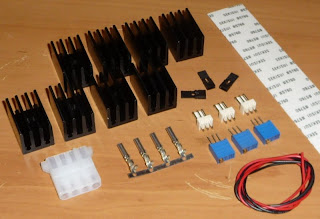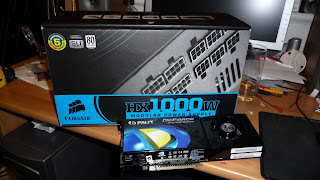Ok, here we go. Time to mod the 4870.
The tools we need:
-
Digital Multimeter. Do not perform any kind of volt mods without one of these.- A low wattage soldering iron. A 15watt dick smith/jaycar cheapie will do the job. Make sure it has a nice sharp tip, otherwise it can get difficult in tight places.
- Some kind of wire cutters/strippers to make life a little easier.
- Small wire. Solid core is better for this stuff imho. I usually cut IDE cables into strips and use them. Perfect size for volt modding.
- A hot glue gun/double sided tape or alternative solution to mount components to pcb.
- Electrical tape (optional)
- 1 x 50ohm trimpot. Used for adjusting gpu voltage. 100ohm is also suitable.
- 2 x 5k multiturn trimpots. Used for adjusting DDR voltage.
- 3 x 3pin fan headers - used for turning the mods on/off.
- 3 x jumpers from an old motherboard/hard drive. used with the 3pin header for on/off control.
- 1 x Molex connector for checking voltages
Now you've got the tools, lets get on with the job.
Here's an overview of the card showing the areas we will be working in and the required voltage reading points. For the MVDDC and MVDDQ read points, you can use any of the points in the highlighted area.

Continuing on with the same techniques as used on the 4850, we will sandwich a trimmer between the pcb and a 3pin fan header. Cut off the pin on the left hand side of the trimmer. Bend the middle leg of the trimmer up towards the middle leg of the fan header and solder them together.
Now turn the trimpot all the way to the left (raise resistance, lower volts) and check that the resistance between the two remaining legs on the trimpot is 50ohm (maximum). Now solder a wire to the remaining leg of the trimpot. This leg will be soldered to the pcb.

Sorry about the cruddy picture, but i forgot to take a shot of the card with the sticker removed. Here's a shot with the wire already soldered on. It's not the best photo but there isn't much going on around it so you shouldn't have too much trouble working out where it goes. The pad that you solder to is quite small here, some people like to add a drop of hotglue to add extra strength to the connection. I trust my soldering.

Now lay the sticker
gently back over the mod. I guess since we haven't removed it, our warranty should be all good... riiiight? Ok, bad joke. Just like the 4850, i put some electrical tape over the wire to prevent it getting caught on anything while handling.

Here's where you have two options. a) Give each mod it's own ground or b) use the same ground point for all mods. I will continue the guide using a mix of both... for extra confusion :).
I use the PCI-E connector as the ground. It's close and very easy to solder to.
Before continuing, double check that the resistance is still set at 50ohms! We wouldn't want to boot up and have a dead card would we?
Memory time!
Hopefully this one should be a little easier since i had a nice photo of this area. The green points are where to solder the remaining leg of the trimpot to. I have highlighted two ground points in yellow. You can either use serperate grounds here or share one between the two. On this card, i shared the top one.

Memory VDDC installed.

Now with the VDDQ installed. Notice how i have soldered the ground wire for this mod to the ground on the MVDDC? This is no advantage/disadvantage to doing this. It just reduces pcb soldering and potential problems. Again, double check that all the trimpots have their resistance set at full!

Here is a close-up of the soldering.

Now get that molex out and start wiring up the reading points! Try not to short connections when soldering to the (somewhat cramped) MVDDC and MVDDQ read points. The VGPU read point will be like a holiday :).
This picture also shows how to use method 'b' as explained earlier. Here you can see that all the ground points have been connected together and go to the one ground (the PCI-E connector). I like this method because it makes things a little bit easier and neater.

And we're all done!
Here's a few pictures of the completed mods :)



Now just add your ramsinks and waterblock of choice and overclock away!

One last note, don't forget to sink the voltage regulators. I haven't done so yet because i had trouble getting anything to stick with thermal tape and i've run out of arctic ahesive. This is a must because they get
hot and you certainly don't want one of them to fry. I need to fix this asap so i'll have a go a modding something on the weekend. Should have a guide up soon after!
Recommended VGPU voltages:Stock - 1.28v
Air - 1.35v max
Water - 1.4v (i saw no increase in mhz after 1.4v. I'd love to know if you get results above this)
DI/LN2 - Who knows, just keep going up :D
Enjoy safe (but extreme) voltage.
























































